- Los Angeles Unified School District
- Operations Services
Facilities Services Division
IPM Publications
| Date | Title | Description | Image | |
|---|---|---|---|---|
| 101 | 01/24/2003 | Program 1: Commensal Rodents | The word "commensal" means living in close association with humans and sharing their food. Three rodent species fall into this category. They are the Norway rat, roof rat, and house mouse. | 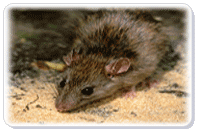 |
| 102 | 02/26/2003 | Program 2: Subterranean Termites | Termites are primitive insects which have been around for over 250 million years. They belong to the order Isoptera -- Iso means equal and ptera means wing. This means that swarmer termites have 4 wings which are equal in size. | 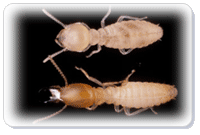 |
| 103 | 04/03/2003 | Program 3: Africanized Honey Bees | In 1956, a well-known honey bee researcher brought queens of African honey bees to Brazil in an attempt to develop a race of bees that would be better suited to Brazilian conditions than the European bees that were there. | 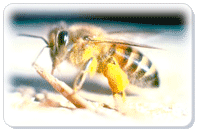 |
| 104 | 05/16/2003 | Program 4: Large Cockroaches | Cockroaches are one of the most successful animals in the evolution of the planet Earth. They are believed to have been associated with humans since the time of cave dwellers. |  |
| 105 | 06/11/2003 | Program 5: Argentine Ants |
|
 |
| 106 | 07/15/2003 | Program 6: Pigeons | Pigeons have often been referred to as flying rats and in many ways they are.
|
 |
| 107 | 08/07/2003 | Program 7: Bird Droppings | A number of diseases are associated with pest birds that frequent human habitation. Refer to LAUSD Pest of the Month publication No. 6 for more information on pigeons. Three species of birds are primarily found in, on, or around human structures. These birds are pigeons, sparrows and starlings. |  |
| 108 | 08/16/2003 | Program 8: Exterior Sanitation | Sanitation is a very important aspect of any pest management program. From an integrated pest management standpoint, it is usually unsanitary conditions that provide food, water, and shelter for most pests. |  |
| 109 | 10/08/2003 | Program 9: Spiders | Most people fear and dislike spiders in spite of the fact that the overwhelming majority of them are beneficial because they feed on insects and other arthropods. | 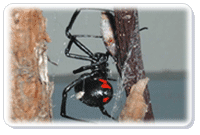 |
| 110 | 11/14/2003 | Program 10: IPM Fundamentals | Los Angeles Unified School District has adopted an Integrated Pest Management (IPM) policy with regards to pest management on District property. The District embraced this policy because it is the right thing to do to protect the health and safety of its students and employees. |  |
| 111 | 01/06/2004 | Program 11: Fleas | In southern California, the cat flea is the most common flea pest of cats, dogs, opossum, skunks, raccoons, wild cats, and some other warm-blooded animals. The dog flea is rare in California and it has been found on some canines such as coyotes. Fleas found on either cats or dogs in California are most likely cat fleas. | 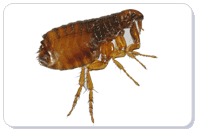 |
| 112 | 02/12/2004 | Program 12: Scavenging Honey Bees | Honey bees, Apis mellifera, evolved on earth at about the same time the flowering plants appeared. These plants need bees to pollinate their flowers so that they could set seed and thus reproduce themselves and survive. |  |
| 113 | 03/04/2004 | Program 13: Subterranean Swarmers | Subterranean termite swarmers are small insects about 8 to 9 mm long with black bodies and four equal transparent wings. When they emerge from a termite colony indoors, they generally fly towards visible daylight that is usually found at a glass window or door because they are trying to go outside. | 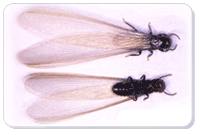 |
| 114 | 04/08/2004 | Program 14: Honey Bee Swarms | Two types of swarms originate from a honey bee colony. The prime swarm and subsequent afterswarms. The prime swarm contains a majority of workers in the nest and the old queen. Afterswarms, which issue about 10 to 15 days after the prime swarm, contain one or more virgin queens and generally a smaller number of workers. | 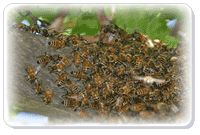 |
| 115 | 05/20/2004 | Program 15: West Nile Virus 1 | To decrease exposure to mosquitos and the infections they may carry:
|
 |
| 116 | 06/01/2004 | Program 16: Pest Droppings | This pictorial key to droppings left by various pests is taken from: US Department of Health, Education, and Welfare, Public Health Service, National Communicable Disease Center, Atlanta, Georgia. Public Health Service Publication No. 1955, US Government Printing Office, Washington, DC. | 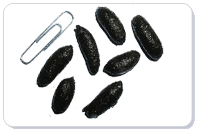 |
| 117 | 06/22/2004 | Program 17: West Nile Virus 2 |
|
 |
| 118 | 07/13/2004 | Program 18: West Nile Virus 3 | Q. What is the West Nile virus (WNV)?
A. WNV is a virus that was first discovered in Uganda in the 1930's. It is very similar to another virus that is present in the United States, St. Louis Encephalitis virus. |
 |
| 119 | 08/12/2004 | Program 19: West Nile Virus 4 | West Nile virus is a significant health threat. Transmitted by mosquitoes, its symptoms include headache, fever, fatigue and muscle aches. Most people recover, but the disease can be fatal. No vaccine exists, but there are steps you can take to protect your family. |  |
| 120 | 11/02/2004 | Program 20: Recognizing Animal Droppings | Occasionally, animal droppings are found within school district buildings. For the most part, these animal droppings (scientifically called scats which is an abbreviation taken from the biological term scatology which is the study of fecal excrement) are left behind by commensal rodents. | 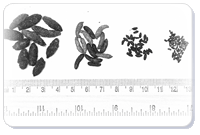 |
| 121 | 01/04/2005 | Program 21: Pest Pictorial Key | Pictorial keys are typical of identification keys found in reference books scientific and papers except that they are arranged as diagrams and illustrated. After making the first choice offered at the top of each page, follow the black lines or indicated numbers to secondary choices until the correct identification has been made. | 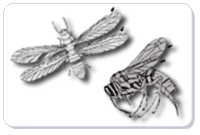 |
| 122 | 02/09/2005 | Program 22: Wild Animals on District Property | Raccoons, opossums, and skunks on district property should be denied access to garbage and other miscellaneous food materials on school grounds. If need be, lock the lids of the dumpsters at night to keep them out. Repair entry points in structures so as to prevent animals from gaining entry. | 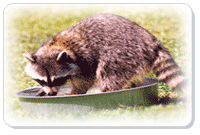 |
| 123 | 05/26/2005 | Program 23: Rattlesnakes | Six species of rattlesnakes are found in various areas of California. Fifteen species occur in the United States. Rattlesnakes are distinctive American serpents. The rattlesnake is California's only native venomous snake. | 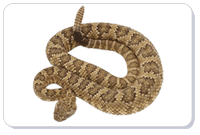 |
| 124 | 07/06/2005 | Program 24: Bug Off! | Whether you are a big target or not, it is smart to take a minute to apply insect repellent with DEET when you know you are going to be outside during peak mosquito-biting hours such as at dawn or dusk |  |
| 125 | 08/11/2005 | Program 25: L.A. County: West Nile Virus | WNV spreads during warm weather months when mosquitoes are most active. While not all mosquitoes carry this virus, the type of mosquito that spreads this virus is found throughout Los Angeles County. | 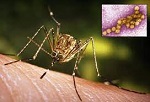 |
| 126 | 10/19/2005 | Program 26: Avian Influenza (Bird Flu) | Bird flu is an infection caused by avian (bird) influenza (flu) viruses. These flu viruses occur naturally among birds. Wild birds worldwide carry the viruses in their intestines, but usually do not get sick from them. |  |
| 127 | 01/06/2006 | Program 27: Cafeteria Pest Management | This program is designed to assist Los Angeles Unified School District cafeteria managers to maintain a good, clean, wholesome, and sanitary environment in which food is stored, prepared, processed, served, and displayed for sale. |  |
| 128 | 03/09/2006 | Program 28: Pigeon Problems | Schools are excellent nurturing and harboring places for large numbers of pigeons. They provide all of the critical and essential requisites for pigeon survival and reproduction, including food, water, nesting and loafing sites... |  |
| 129 | 03/22/2006 | Program 29: West Nile Virus 5 | Mosquitoes have always been a nuisance in California but with the arrival of West Nile Virus, they are now a serious health threat. Mosquitoes are the main vectors of West Nile Virus, a debilitating disease which can be fatal to people, horses, and certain species of birds, for example, crows. |  |
| 130 | 03/29/2006 | Program 30: Avian Influenza (Bird Flu) | Infected birds shed virus in their saliva, nasal secretions, and feces. Susceptible birds become infected when they contact contaminated excretions. It is believed that most cases of bird flu infections in humans have resulted from contact with infected poultry or contaminated surfaces. |  |
| 131 | 06/13/2006 | Program 31: Rats and Mice | Rats and mice often invade schools and other District buildings to look for food, water, and shelter. Once inside structures, these animals often chew on many materials such as food, food containers, books, cardboard, paper, paper products, plastic bags, art projects, and electrical wires, etc. |  |
| 132 | 06/20/2006 | Program 32: West Nile Virus 6 | West Nile Virus (WNV) season has arrived and residents should take precautions with the advent of warmer weather and more leisure time spent outside, experts advise. |  |
| 133 | 11/01/2006 | Program 33: IPM Flyers Pigeons & Pests |
|
 |
| 134 | 07/24/2007 | Program 34: Mosquitoes and WNV | To prevent mosquito from breeding on district properties.
|
 |
| 135 | 07/24/2007 | Program 35: West Nile Resurgence in California 2007 | In order to impact mosquito breeding, we need to pay attention to all outdoor water uses to make sure we are not creating stagnant water puddles for mosquitoes to breed in. |  |
| 136 | 08/21/2007 | Program 36: Bats on School Grounds | When people hear about bats, they often imagine or think things that are not true. Bats are not blind. They use a sophisticated system called echolocation to find their prey. They are neither rodents nor birds. |  |
| 137 | 03/25/2008 | Program 37: Cats on District Property | What is a feral cat? A feral cat is an animal that is too poorly socialized to be handled (and therefore must be trapped or sedated for examination) and which cannot be placed into a typical pet home. |  |
| 138 | 09/16/2008 | Program 38: Bed Bugs | Bed bugs are small, agile, secretive, cryptic, covert, insidious insects that can very easily crawl into suitcases, luggage, boxes, and other belongings. Evolution and natural selection have shaped bed bugs into an insect that is flat and thin and is highly adaptable. | |
| 139 | 11/06/2012 | Program 39: Filth Flies | Many species of flies can be problems in schools. Flies such as house flies and blow flies which breed in food wastes (garbage) and/or animal feces are generally referred to as filth flies. |
-
Integrated Pest Management
-
Maintenance & Operations
M&O Home Page M&O Contact Information
- Email: mo.administration@lausd.net
- Phone: (213) 241-0352
- Contact List (Sept 2025)
- CPM Directory
-
Operations Services
-
Design Department
Copyright © 2025 Finalsite - all rights reserved.

